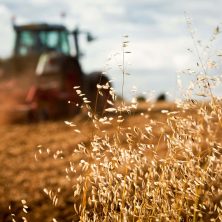Ukraine spends considerable amounts of agricultural subsidies (US$ 250 mn. per year) or 0.5% of total State Budget expenditures in ways that are not conducive to the objective of helping to correct for policy failures (agric. sales moratorium) that prevented movement towards higher value added and a more diversified agricultural sector because of (i) a fragmented structure and ad hoc delivery that biased support towards large farms; (ii) limited scope for recouping public investment via taxation of the agricultural sector; and (iii) constraints on investment incentives and credit access due to the moratorium on agricultural land sales.
To increase the effectiveness of existing subsidies, we propose to focus on three types of expenditures, namely:
- targeted partial support to productive investment by small & medium farmers in business line with high value added (i.e. excluding grains & oilseeds) via matching grants (preferable) or alternatively interest rate subsidies;
- support to capitalizing and running a partial credit guarantee facility to support productive investments by this target group; and
- support to financial literacy training and knowledge transfer to increase the target group’s awareness of diversification options and enable them to put together bankable investment proposals.
As data on the small and medium scale sector in Ukraine is virtually non-existent, this will be combined with establishment of a farmer registry that would allow private sector, central, and local governments to gradually improve focus and targeting of support to the agricultural sector, including through investment in local public goods.
What is the rationale for public support to Ukraine’s agricultural sector?
Ukraine’s agricultural productivity is a fraction of that in European countries with 2014 agricultural value added per hectare of $ 413 compared to $1,142 in Poland, $1,507 in Germany, and $2,444 in France. A key reason for this is that production focuses on lower value-added products (such as grains or oilseeds) suitable for mechanized cultivation. Public efforts to increase productivity can be justified if they focus on addressing market imperfections to level off the playing field, provide public goods, and exploit the potential of recouping all or part of the investments made via increased tax receipts. Below we provide the details for these types of support.
Addressing market imperfections: Characteristics of the agricultural sector lead to information problems that make access to credit difficult, especially for small farmers. While the use of land as a collateral for loans is common to overcome these, the land sales moratorium made this impossible, so that small producers could not access credit for working capital or investment putting them on a strategic disadvantage compared to larger ones. Even if land can be used as a collateral, the fact that large part of the transaction costs of providing credit is fixed implies that even if they have creditworthy projects, small farmers may have difficulty getting a loan.
Moreover, over the last two decades, agricultural support in the form of substantial tax benefits and direct budget outlays has always been favoring large producers thus creating unequal conditions for developing the small ones. This partially distorted the farm structures towards the large and mega-large agriholdings in Ukraine and left less space for improving productivity and diversification of the small farms.
Providing public goods: Many forms of agricultural technology as well as public infrastructure (including irrigation) have public good characteristics and will not be provided at the appropriate level by the market so that public provision will be socially optimal. Coordination problems related to provision of knowledge and productive infrastructure can be overcome by appropriate public action, e.g. via extension services and planning of public infrastructure provision.
Sustaining expenditures: While many countries see agriculture as a recipient of net subsidies, spending to support the sector can in principle be recouped via taxation. In fact, several of Ukraine’s main competitors (e.g. Argentina) impose a considerable tax burden on their agricultural sector. Providing temporary support in the hope of recouping it via taxes from the sector in the future is thus legitimate and potentially viable.
Why Ukraine’s current structure of farm support is inefficient and unsustainable?
Ukraine spends $ 250 mn. annually on subsidies to the agricultural sector under programs that generally aim to increase processing and value added in the sector. While the goal of diversifying the sector towards higher value added is appropriate to have diversified and more productive agriculture, the instruments used suffer from shortcomings that increase associated transaction costs, exclude small farmers who may need these programs most, subsidize investments and purchases that would have been made in any case, and are inappropriate for achieving sustained growth.
Fragmented/ad-hoc design and execution: Support is provided via 24 separate programs that partly overlap (e.g. 3 programs for concessional credit), that may pursue conflicting goals (e.g. restriction on domestically produced agricultural machinery), restrict flexibility in responding to demand and limit predictability. Moreover, ad-hoc design and execution of the subsidy programs compromises the trust to support programs and does not allow to incorporate them into farmers’ business plans. Government thus subsidizes investments and purchases that would have been made in any case, spending taxpayers’ money inefficiently.
Poor targeting: As programs require significant amounts of paperwork and only reimburse for expenditures ex post, they are difficult to access for credit-constrained (small) farmers. As a result, most of the support provided naturally accrues to large farms. In fact each year two to three large agricultural companies receive more than half of subsidies – to the detriment of smaller ones who would be more in need of such support.
Limited sustainability: The objective of a subsidy program should be to generate higher revenues at least some of which could then be recouped via taxes. Yet, with most enterprises opting for the simplified tax regime, Ukraine’s agricultural sector is taxed only very lightly at a rate that is unrelated to profits. Current subsidies are tied to inputs that distort incentives. And evidence suggests that such coupled subsidies tend to reduce efficiency and productivity, thus limiting growth perspectives for the sector.
What would be the outlines of an alternative structure for agricultural support?
Rather than trying to ‘pick winners’, we suggest that public support to the agricultural sector focuses on achieving high overall sustainable productivity and competitiveness growth and resilience through targeted support to correct for market failures and for more diversified agricultural portfolio/production structure.
Support to public goods: Knowledge transfer and financial literacy training should be provided to increase small farmers’ awareness and enable them to put together viable investment proposals. This can be linked to support to other public goods (e.g. sanitary and phytosanitary measures, food safety, information systems, physical rural infrastructure, education and R&D) and is essential to increase return on investments and export potential.
Improving access to credit: Small farms are disadvantaged in access to financial services due to information asymmetry and transaction costs. They have no bank-friendly financial reporting (due to the simplified system of taxation and reporting in the agricultural sector) and lack credit history and collateral, making it difficult for banks to assess the risks of extending credit to them. This problem is reinforced by the agricultural land sales moratorium. While lifting of the moratorium on agricultural land sales provides the preconditions for use of land as collateral for credit markets, credit history by potential borrowers, and familiarity with the sector by banks implies that initially the risk of providing credit to the agricultural sector remains high. A partial credit guarantee (PCG) can reduce such risks without eliminating the responsibility by banks, ideally in combination with other risk management techniques (e.g. crop insurance) to address systemic risk.
Investment support to (new) agricultural entrepreneurs: Agricultural support policy in Ukraine in the form of substantial tax benefits and subsidies has always been pro-large thus putting small producers at disadvantage. To allow small (emerging) farmers compete on an equal footing with larger and established players and correct for a long-lasting policy failure, reshuffling current highly inefficient, distortive and unfair subsidies towards a simple and targeted support to facilitate capital upgrade and diversification may be needed. This could take the form of (i) matching grants; (ii) interest rate subsidies; or (iii) transaction cost subsidies to compensate banks for the cost of serving small clients. Such programs should highly rely on good quality financial intermediaries and could be administered jointly by an entity in charge of providing a partial credit guarantee. Targeting the purpose of financing and clientele is a key element. Targeting capital investments should be a priority, but working capital financing should not be completely excluded either. The target group should be defined carefully. Eligibility criteria should primarily focus on farms turnover and based on the existing evidence. In Ukraine, we suggest to limit the program to farms with up to $0.55 mln of annual turnover. Also, to pursue diversification, oilseed, grains and poultry farms should be excluded from the target farms. Regular evaluation and auditing of the program is essential.
A complete paper on the issue can be found here.
Attention
The authors do not work for, consult to, own shares in or receive funding from any company or organization that would benefit from this article, and have no relevant affiliations





